Episodes
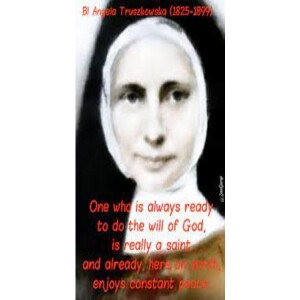
Tuesday Jan 30, 2024
Tuesday Jan 30, 2024
Stand In The Gap With Us And Blessed Mary Angela Truszkowska 1/30/2024
Blessed Mary Angela Truszkowska, baptized as Sophia Camille, was born in Kalisz, Poland, on May 16, 1825. Members of noble families, her parents were well-educated. Her mother, a devout Catholic, had a great influence on her faith.
Today we honor a woman who submitted to God’s will throughout her life—a life filled with pain and suffering. Born in 1825 in central Poland and baptized Sophia, she contracted tuberculosis as a young girl. The forced period of convalescence gave her ample time for reflection.
As a child, Sophia was highly intelligent and generous. However, because of her fragile health, most of her education was completed at home under the supervision of private tutors. Her days as a young student were characterized by schoolwork and reading, as well as daily Mass, adoration of the Blessed Sacrament and nightly prayer.
Her compassion for the underprivileged grew as she gained invaluable insight into the social ills and issues of her time from her father, a juvenile court judge.
Sophia seriously considered joining the cloistered Visitation Sisters. However, at the age of 23, while traveling with her ailing father, she was enlightened by the Lord during her prayer in the cathedral of Cologne. Despite her love of prayer and solitude, she was destined to go among the suffering poor and to serve Christ in them.
Sophia felt called to serve God by working with the poor, including street children and the elderly homeless in Warsaw’s slums. In time, her cousin joined her in the work.
The residents of the Capital City, upon seeing the little group of children being led before the St Felix altar in the Capuchin church, started calling them children of St Felix. With time, the name Felician became associated with the sisters.
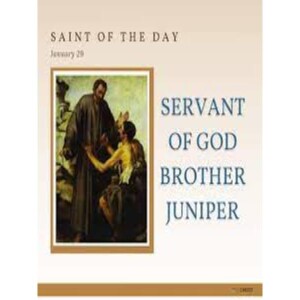
Monday Jan 29, 2024
Monday Jan 29, 2024
Stand In The Gap With Us And Servant of God Brother Juniper 1/28/2024
Saint Juniper (San Ginepro, d.1258), called "the renowned jester of the Lord," was one of the original followers of Saint Francis of Assisi, admitted to the order in 1210 by St. Francis. Juniper established Franciscan missions in various locations, and when St. Clare of Assisi was dying, he was at her side.
Brother Juniper was a close friend and one of the first followers of St. Francis of Assisi. He had such compassion for the poor that he continually gave away whatever he had including his coat and shirt.
Brother Juniper joined the Franciscan Order in 1210 and he helped establish monasteries in Viterbo and Gualdo Tadino, Italy. He is depicted in the "Little Flowers of St. Francis"
The Servant of God, Juniper, O.F.M., best known as Brother Juniper (Italian: Fra Ginepro) (died 1258), called "the renowned jester of the Lord," was one of the original followers of St.Francis of Assisi. Not much is known about Juniper before he joined the friars.
The devils could not endure the purity of Brother Juniper's innocence and his profound humility, as appears in the following example: A certain demoniac one day fled in an unaccustomed manner, and through devious paths, seven miles from his home. When his parents, who had followed him in great distress of mind, at last overtook him, they asked him why he had fled in this strange way. The demoniac answered: "Because that fool Juniper was coming this way. I could not endure his presence, and therefore, rather than wait his coming,
“Would to God, my brothers, I had a whole forest of such Junipers,” said Francis of this holy friar.
Once upon a time the devil, desiring to terrify Brother Juniper, and to raise up scandal and tribulation against him, betook himself to a most cruel tyrant,
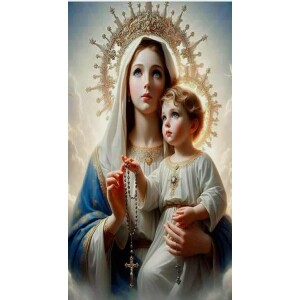
Monday Jan 29, 2024
Monday Jan 29, 2024
Join John Carpenter. Don Hartley, and the Deeper Truth research team as we investigate another apparition of the Virgin Mary in 1874.
May 12: On this day in 1874, Our Lady appeared to shepherd children:
Vincenzo Scossiera (12), and Angela Berruti (13).Angela saw the Virgin Mary in a cloud wearing a brown colour dress and veil, she beckoned her to come closer.
Vincenzo saw the lady in blue but became scared and ran to his house.
Later, others saw Our Lady, she was even seen dressed in black. She asked for a chapel to be built upon that site despite opposition from authorities.
Our Lady is one who assists Christians as a community, through her intercession, in fighting against anti-Christian forces.
To thee do I come, before thee I stand, sinful and sorrowful, O Mother of the Word Incarnate, despise not my petitions, but in thy mercy hear and answer me. Amen. Mary, Help of Christians, you are the Queen of Martyrs. Help us to be devoted Christians in life and through death.
After the battle of Lepanto on October 7, 1671, at which a Turkish fleet was feated by a Christian fleet, Pope Pius V, who had previously called upon Catholics to invoke Mary's assistance so that the Turkish threat may be averted, inserted the title “Help of Christians”
Saint Pius V gave Mary the title: "Help of Christians," after the victory of the Christian fleet over the Turks at Lepanto on October 7, 1571, and he added this invocation to her litany.
O Mary, most powerful Virgin, great and illustrious defender of the Church, wonderful Help of Christians, formidable as an army in battle array, you who have overcome every heresy in the world, in our anguish, in our combats, in our difficulties, defend us from the Enemy, and at the hour of our death receive our souls into Paradise. Amen.
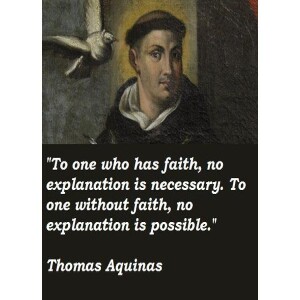
Sunday Jan 28, 2024
Sunday Jan 28, 2024
Deepertruth: Stand In The Gap With Us And Saint Thomas Aquinas 1/28/2024
At 5-years-old, Thomas began his education at Monte Cassino, where he remained until the military conflict between Emperor Frederick II and Pope Gregory IX reached the abbey. He was then transferred and enrolled at the studium generale in Naples.
Thomas Aquinas was the greatest of the Scholastic philosophers. He produced a comprehensive synthesis of Christian theology and Aristotelian philosophy that influenced Roman Catholic doctrine for centuries and was adopted as the official philosophy of the church in 1917.
By universal consent, Thomas Aquinas is the preeminent spokesman of the Catholic tradition of reason and of divine revelation. He is one of the great teachers of the medieval Catholic Church,or of the Church and Angelic Doctor. honored with the titles Doctor.
When Thomas' family learned of his decision, his mother Theodora arranged for him to be moved to Paris. When Thomas was travelling to Rome, his brothers captured him and returned him to their parents at the castle of Monte San Giovanni Campano.
By 1243, Thomas abandoned his family’s plans for him and joined the Dominicans, much to his mother’s dismay. On her order, Thomas was captured by his brother and kept at home for over a year.
Aquinas's parents, hoping he might come to his senses, conspired to have him kidnapped and imprisoned for more than a year in the family castle.
Aquinas got on with writing logical treatises, until his brothers tried to make him see the error of his ways by helpfully inserting a prostitute into his cell. Aquinas, in a perhaps unprecendented display of monkish restraint, did not succumb to her worldly charms, but rather, wielding a burning stick, chased her from the castle.
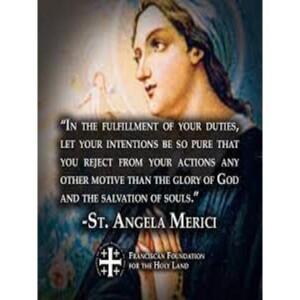
Saturday Jan 27, 2024
Saturday Jan 27, 2024
Stand In The Gap With Us And Saint Angela Merici 1/27/2024
St Angela Merici was born in the year 1470 at Decenzano, northern Italy, on the banks of Lake Garda. Even as a child she served God very fervently. She so loved modesty and purity of heart that she was quite generally venerated as a little saint in her native town.
When she was in her 13th year she entered the Third Order of St. Francis, and soon afterward took the vow of perpetual chastity, renounced all her possessions, and wished to live only on alms.
Along with this St Angela Merici practiced great austerities, slept on the bare earth, and fasted continuously on bread and water. Sometimes Holy Communion was her only food over a period of several days.
When St Angela Merici was 23 years old, Angela was praying one day in a secluded place, and there she had a vision of a friend who had died a short while before. Her friend prophesied that Angela would be the foundress of a religious institute which would be devoted to the education of youth, and destined to do an unlimited amount of good for the kingdom of God. That proved to be a great incentive for Angela, not only to lead a life of contemplation, but also to serve her fellowmen in active work.
St Angela Merici gathered about her a group of young women, and together they went out to give religious instruction to little children, to help the poor, and to care for the sick. Often there were great sinners among those to whom she ministered, and in such cases she did not cease instructing, entreating, and encouraging them until they were reconciled with God and began to lead a new life.
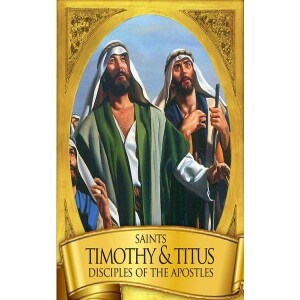
Friday Jan 26, 2024
Friday Jan 26, 2024
Stand In The Gap With Us And St Timothy and Titus 1/26/2024
By the time I was born, my Mother had already begun investigating the Catholic Faith and she decided to name me after St. Timothy.
Growing up, I did not understand that but I certainly was called Tim, Timothy, Timmy even though it was my middle name. I actually thought Timothy was a sissy name so when I got older, I preferred my first name, Donald. Donald comes from the Celtic language meaning Chief.
When I began to really take a strong look at my Catholic roots in the latter 1970's, I began to discover who St. Timothy was and I began to appreciate my Mother's reason for naming me after St. Timothy.
The name Timothy comes from the Greek meaning, "honoring God" or "honored by God" which certainly means a lot to me now!
St. Timothy was born near Lycaonian which was located in Asia Minor (modern day Turkey) who became a Catholic Convert through the teaching of St. Paul. 2 Timothy 1:5 St. Paul writes to Timothy, "I am reminded of your sincere faith, a faith that dwelt first in your grandmother Lois and your mother Eunice and now, I am sure, dwells in you as well."
The faith that Timothy was taught came from the Jews so the Old Testament Scriptures were what St. Paul was speaking of, but Timothy received the oral teaching of the New Testament from St. Paul. St. Paul visited Lystra about 50 A.D. finding Timothy being well respected in the Community.
At this point, St. Paul invited Timothy to travel with him on his journeys spreading the Gospel. It was through the authority of St. Paul that Timothy was ordained to the priesthood. 1 Timothy 4:14-16 states, "Do not neglect the gift you have, which was given you by prophetic utterance when the council of elders laid their hands upon you.

Thursday Jan 25, 2024
Thursday Jan 25, 2024
Stand In The Gap With Us And Honor The Conversion Of St. Paul 1/25/2024
Jesus identifies himself totally to his Church, Acts 9:1-9 states, “Saul, still breathing murderous threats against the disciples of the Lord, went to the high priest and asked him for letters to the synagogues in Damascus, that,if he should find any men or women who belonged to the Way, he might bring them back to Jerusalem in chains.
On his journey, as he was nearing Damascus, a light from the sky suddenly flashed around him. He fell to the ground and heard a voice saying to him, “Saul, Saul, why are you persecuting me?” He said, “Who are you, sir?”
The reply came, “I am Jesus, whom you are persecuting. Now get up and go into the city and you will be told what you must do.” The men who were traveling with him stood speechless, for they heard the voice but could see no one. Saul got up from the ground, but when he opened his eyes he could see nothing; so they led him by the hand and brought him to Damascus. For three days he was unable to see, and he neither ate nor drank.”
One sentence determined his theology: “I am Jesus, whom you are persecuting” (Acts 9:5b). Jesus was mysteriously identified with people—the loving group of people Saul had been running down like criminals. Jesus, he saw, was the mysterious fulfillment of all he had been blindly pursuing.
From then on, his only work was to “present everyone perfect in Christ. For this I labor and struggle, in accord with the exercise of his power working within me” (Colossians 1:28b-29). “For our gospel did not come to you in word alone, but also in power and in the Holy Spirit and [with] much conviction” (1 Thessalonians 1:5a).
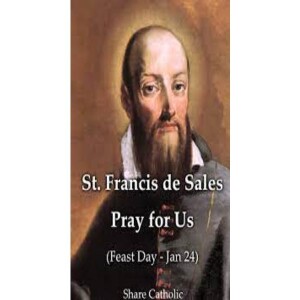
Wednesday Jan 24, 2024
Wednesday Jan 24, 2024
Stand In The Gap With Us And Saint Francis de Sales 1/24/2024
The city of Geneva in Switzerland is situated at the western end of the forty-five mile long lade of the same name, near the French boundary. In the sixteenth century the Dukedom of Savoy lost this city, as well as the province of Vaud on the north side of the lake and that of Chablais on the south side, to the Calvinists of Switzerland.
By giving up his claim to Vaud, the duke of Savoy finally regained Chablais; but the people of the latter province had meanwhile become fanatical Calvinists. The bishop of Geneva resided at Annecy, some twenty miles south of Geneva.
A prominent noble family of Savoy at this time was that of De Sales; and Saint Francis de Sales, who was born in 1567 at the Chateau de Sales, near Annecy, became its most illustrious member.
He was appointed to the chair of the Annecy cathedral chapter, and was ordained priest on 18 December 1593.
His early years of priesthood in the Calvinistic district of Chablais were largely coloured, perforce, by extraordinary missionary controversy.
Already from the year 1534 the city of Geneva had become the bastion of Protestantism, and Calvin had conquered the whole region.
The Catholic faith was suppressed with raids, pillaging and massacres; churches were destroyed, worship forbidden, priests exiled or done to death.
In 1877 he became the first writer in French to be named doctor of the church. In addition to his spiritual works, his writings include controversies against Calvinists, letters, sermons, and documents on diocesan administration.
His bishop sent him to Rome on diocesan business; and on 24 March 1599 he was appointed coadjutor bishop at the age of thirty-one.
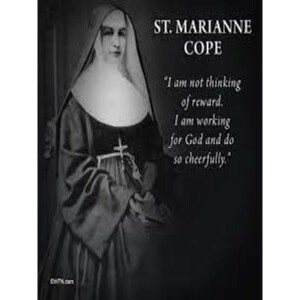
Tuesday Jan 23, 2024
Tuesday Jan 23, 2024
Stand In The Gap With Us And Saint Marianne Cope 1/23/2024
St. Marianne Cope was born Barbara Koob on Jan. 23, 1838, in Hessen, West Germany. A year after she was born, the family immigrated to Utica, N.Y., where the surname Koob became Cope. Barbara became a U.S. citizen when her father was naturalized.
J.F. Bowler, a leading Catholic laywoman at the time, who said Mother Marianne “risked her own life … faced everything with unflinching courage and smiled sweetly throughout it all. … She was a heroine in her life; she is a martyr in death.”
Though leprosy scared off most people in 19th-century Hawaii, that disease sparked great generosity in the woman who came to be known as Mother Marianne of Molokai. Her courage helped tremendously to improve the lives of its victims in Hawaii, a territory annexed to the United States during her lifetime (1898).
Mother Marianne’s generosity and courage were celebrated at her May 14, 2005, beatification in Rome. She was a woman who spoke “the language of truth and love” to the world, said Cardinal José Saraiva Martins, prefect of the Congregation for Saints’ Causes. Cardinal Martins, who presided at the beatification Mass in St. Peter’s Basilica, called her life “a wonderful work of divine grace.” Speaking of her special love for persons suffering from leprosy, he said, “She saw in them the suffering face of Jesus. Like the Good Samaritan, she became their mother.”
Her father died in 1862, and this along with her siblings maturity, permitted her to leave the factory to pursue a religious life. She became a novitiate of the Sisters of the Third Order Regular of Saint Francis based in Syracuse, New York. She took the name Marianne when she completed her formation.
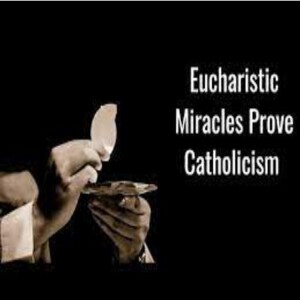
Tuesday Jan 23, 2024
Tuesday Jan 23, 2024
Catholic converts tell their stories of Eucharistic reckoning
Bishop James Conley of Lincoln, Nebraska, said during discussion that, speaking as a convert, “It was really the Catholic teaching on the Holy Eucharist, the Real Presence, that drew me into the Catholic Church.” Over the years, many high-profile converts have shared the same.
Bishop Conley and two other prominent Catholic converts — best-selling author and Scripture teacher Sonja Corbitt and theologian, author and apologist Scott Hahn — share how the Eucharist drew them to Catholicism.
Bishop Conley was a college student when his immersion i a Great Books program at the University of Kansas got him thinking about the serious questions of life, including the practice of religion.
Raised as a nominal Presbyterian, he had considered himself agnostic when he entered college. Exposure to the transcendentals — truth, beauty and goodness — now led him in search of God.
“I started hopping around to different churches,” he told the Register, listing Presbyterian, Methodist and Episcopalian. “Most churches I attended had some form of holy communion.”
“That struck me,” Bishop Conley said, “that Christ is truly present, objectively.”
He was also moved that the Catholic Church faithfully follows Christ’s command to the apostles, “Do this in memory of me” (Luke 22:19). “In other words,” Bishop Conley said, “continue this.”
